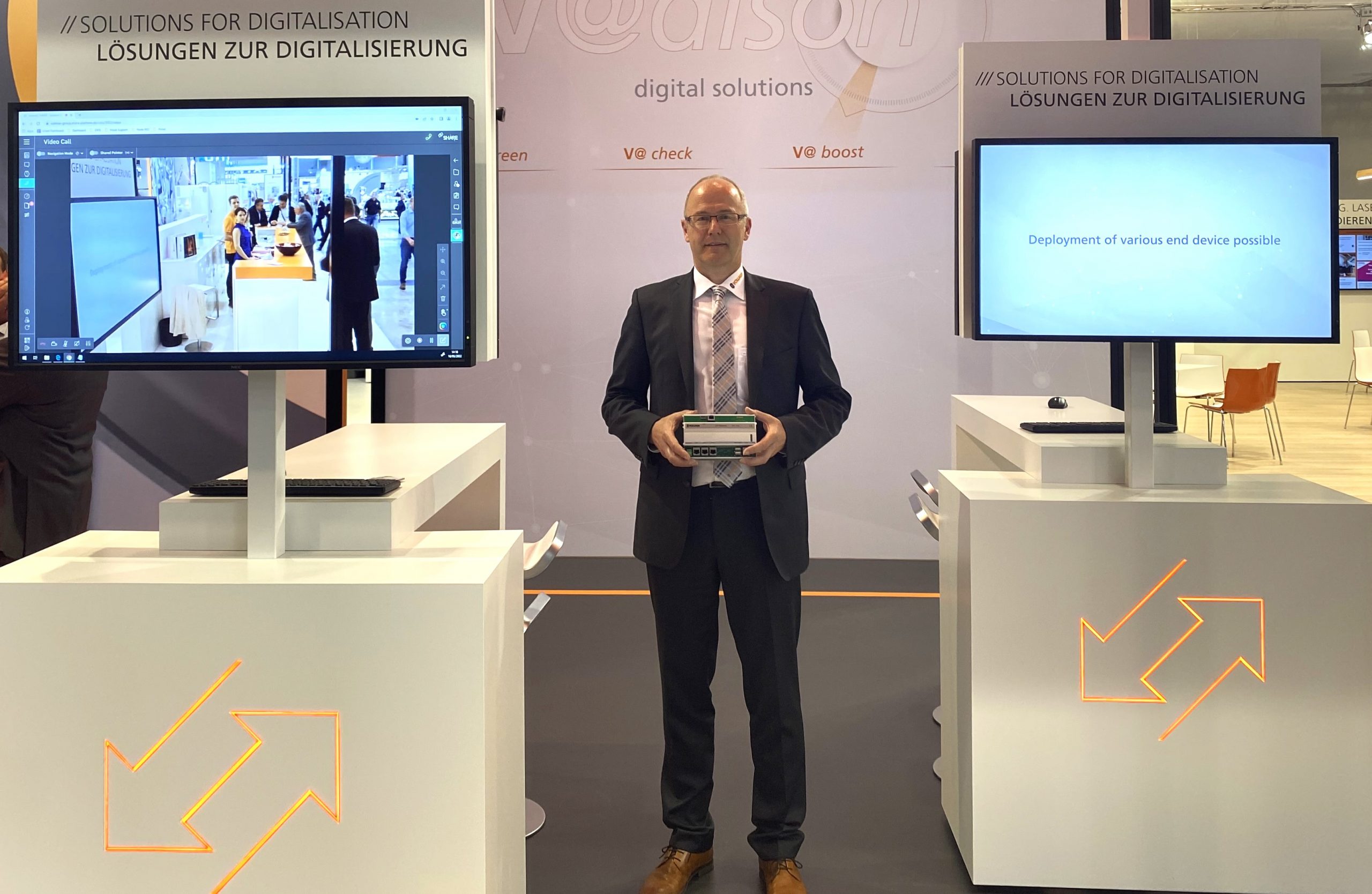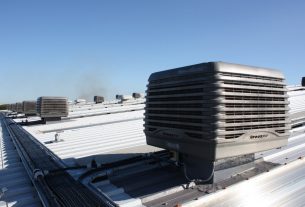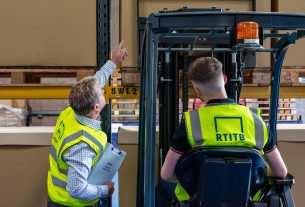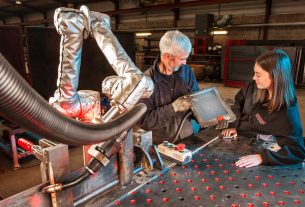Industry 4.0, the Internet of Things (IoT) and digitalisation – whatever you want to call it, the Fourth Industrial Revolution is here and moving at a great pace. With the dawn of a new age upon us, nobody can fully calculate the impact and benefits the new world of industrial connectivity will have upon us. VOLLMER has been developing its Digital Strategy called V@dison since 2016 and customers are already reaping the rewards of this technology.
Ironically, whilst the pandemic prevented a fanfare roll-out and world premiere of Visual support /Visual instruct at an international trade fair in March 2020 – it was the same pandemic that accelerated the V@dison market penetration, as an integration of digitalisation in our daily lives deepened. For many, the use of Teams, Zoom and other communication platforms rapidly became the norm. We all recognised the advantages of technology during such a challenging time, but for a global machine tool manufacturer, a simple Zoom call to customers just doesn’t ‘cut-it’. For some, digitalisation and talk of a fourth industrial revolution still creates confusion, bewilderment and a lack of interest – all caused by a lack of education. Instead of trying to educate readers, we speak with Wolfgang Miller, Customer Services Director at VOLLMER to identify some of the features, and the benefits customers are reaping from V@dison.
To fundamentally understand the start of the digital journey, Wolfgang says: “Machines from 20 years ago were mainly driven by mechanical parts and now, everything has electrical parts and is electrically driven – therefore it is digital. So, we have to adapt our systems and behaviour and move towards digitalisation. Digitalisation is not only having digital components but giving the customer information through digital systems. Our digital system is actually Oculavis and it allows us to see what the customer is doing in front of the machine. This means we can assist and instruct the operator and provide them with the next steps in the service operation, eliminating any communication errors between VOLLMER and the customer that may be created by not seeing what the customer sees.”
What does this mean for the customer?
“Instead of receiving customers emails, images and documents that are open to interpretation and error, we see what the customer sees. For us to react in the right way, we need the right information. The time between a customer recognising a problem and requiring a solution has compressed. Previously, one or two days to resolve a service issue was acceptable – now customers want a response in less than one or two hours – it is critical. With Visual Suport, we can react faster and provide the right solution without excessive communication. With the correct information, we can implement a right-first-time approach that eliminates errors through communication. In a global marketplace, language, terminology, miscommunication and even time-zones can disrupt service response – digitisation will eradicate these issues.”
Keeping spindles turning
In an age where maximum spindle utilisation, time and cost pressures and the ever-increasing demand for improved customer service throughout the supply chain is critical, digitalisation is changing the landscape for businesses. As Wolfgang adds: “In the past, with different systems, components and software across a range of machines and technologies, it wasn’t possible to enter the machine system, now we can log on to the machine and work remotely with the customer to get the machine running in little more than an hour. This is critical for customers outside of Europe – you can lose hours with time differences on different continents. You could quite easily lose a full day, with Visual Suport we can get machines operational much faster.”
V@dison empowers the customer to undertake maintenance tasks without a VOLLMER engineer physically present. This can get the machine up and running with immediacy, reducing the reliance on a ‘call-out’, which incurs the inevitable time and cost implications. To do this, we must have the facility to gather the most accurate information from the machine. In the past, the human was always the conduit between the machine and VOLLMER. They would find an error message, take a photograph and send it to us. If it was not clear, time could be lost in communication. Now, we can log onto the machine, see what the issue is and react quicker and more accurately.
Building the digital foundation
The digital journey started with VOLLMER determining what information is needed to create the foundation blocks of a digital platform. With countless meetings with global subsidiaries, the formation of internal teams, structured workshops and the utilisation of external digital experts – VOLLMER now has an exceptional digital strategy. Internal teams communicate across departments and divisions working on integrating digitisation into every facet of the business, but the journey has no end point in a world of continuous evolution.
Commenting on just a few of the trigger points where digitisation is transforming the internal structures at VOLLMER to enhance customer experience and add value, Wolfgang continues: “We started by identifying 36 different themes to work on. As a brief example, some of these included reducing our number of control systems. We had five systems across the different machine technologies and we have reduced this to three – we will not stop there. The result is that our engineers will have one control system for collecting data on their laptops rather than requiring multiple systems and cables, simplifying and streamlining processes. Another point was spare parts. We decided to give the customer the complete data and structure of the machine to choose the spare parts they need. Now, they can select the 3D drawing and identify the component required. To fully eliminate errors and create certainty, we are now photographing more than 36,000 parts from across our machine platforms to add to the data library for customers. Added to this, we are creating service and maintenance videos.”
“The journey is a huge investment for VOLLMER, but we can now talk to customers about our online shop, the pictures of spare parts, the IoT Gateway, the Visual Support and Visual Instruct packages – all elements of our digitalisation vision that will complete our service offering.”
Opening up the IoT
Implementing fundamental changes to the business structure and processes at VOLLMER is a colossal task that will reap benefits and streamline operations for both VOLLMER and its customers. “One key priority has been accessing the machine. We could not see directly what the customer could see and what signals were being shown in the electrical cabinet. We have now installed FastViewer or TeamViewer on every new machine and it can be installed on existing machines. To provide us with access to older legacy machines, we created an update kit whereby a new cost-effective operating computer could be installed with the update. We can now go back to machines manufactured in 2000 and even further. This enables us to help customers worldwide and it is particularly helpful in instances where the local subsidiary cannot get to the customer site for any given reason. Just look at the pandemic – worldwide travel restrictions prevented us from visiting and supporting customers, Visual Suport provided that support remotely.”
Going Live
Allowing the machine tool vendor to access the machine remotely to investigate issues is of huge benefit to the customer, as Wolfgang adds: “To give one example, you can grind 0.3mm of stock material and everything is okay, but then you could enter at the same parameter 3mm – 10 times more material to remove. The machine will identify the variation through a different grinding stroke, a motor overload or another error message on the machine. The customer will only see an error message and identify there is an issue without knowing the exact problem. We can enter the machine, and see the current being drawn, the increased power requirement and the pattern of the motor, before it stops. From this information, we can identify the exact issue.”
“The VOLLMER system stores information on the machine for 28-30 days, so we can see what days and dates the error started and the processes and parameters leading up to the error message. We can then identify growing patterns and what components may have failed. So, we have the indirect recording over the lifetime of the machine and also on a 30-day block, so if the failure is immediate it could be an error input from the operator – but we can also see the critical steps towards failure. We can collect a lot of data from the machine, but the customer only sees a few parameters on the screen. This is because it does not help the customer to have lines of code on the screen, they just want to see whether the spindle and coolant is or isn’t turning or flowing. This builds process security and eliminates the opportunity for error in service and reporting.”
Another major benefit is creating standardisation, as Wolfgang continues: “Some customers are running machines 20+ years old with an old operating system – when they relay an issue, we have to locate the correct technician to deal with that legacy machine. We may not always have the correct service staff available to fulfil the needs of the customer if the machine is very old. With the new system, it doesn’t matter if the machine is two or 20 years old, it will be the same control system. Everything we work with is now on the same system. With the software we now plug in, you can choose whatever you wish with the same digitalisation system and the same way of servicing the machines – this is creating standardisation for VOLLMER and building a more robust service platform for customers with old machines.”
Security
For VOLLMER, one of the next steps will be to install the IoT gateway on all machines, discussing this, Wolfgang says: “When all of our communication platforms are completed, we can update all of our machines – making all of our machines IoT gateway ready. The internal system is currently in the VOLLMER language and as soon as the systems are complete and the OPC UA and UMATI interfaces are ready, we will switch to the new channels. This switchover will not impact customers, but the new IoT Gateway will improve data network security as the systems have to adhere to directives from the European Central Government. Therefore, we have certificates and targets to meet every couple of months. This means the IoT gateway and the machine tools will be a completely closed-loop communicating through a single channel. The security and the ability to prevent viruses or attacks from external parties will be a big benefit for the customer.”
Qualifying the benefits
Alluding to the quantifiable benefits of V@dison, Wolfgang says: “Comparing our first year of V@dison roll-out against the previous ‘Covid’ year cannot be accurately qualified due to exceptional circumstances. One thing that we can qualify, is that during Covid we did not lose any level of service to our customers. We managed to complete the same number of worldwide services for clients. If you ask the customer – manufacturers with machines under warranty would find no difference in the service support costs. However, for customers with machines out of warranty that have to pay for our services, they are saving on the travel and time costs of our engineers. Another major point is that during the pandemic, we did not have to extend our new machine delivery lead times based on engineer availability. This is because, with the Visual Suport suite, our customer installations could be undertaken online.”
Looking at this more closely and the potential of the digital platform to reduce the reliance on the physical attendance of a VOLLMER engineer at a customer site, Wolfgang says: “We cannot accurately calculate the savings that digitalisation will bring to both VOLLMER and our customers. But as an example, we had machines delivered and installed during the pandemic when our engineers couldn’t travel anywhere. In the past, a machine would have been delivered and sat at the customer facility on a pallet with nothing happening. With our new digital product, we cooperated with our customers and conducted countless remote installations throughout the pandemic, despite worldwide travel restrictions. We guided customers step-by-step on what to do, so we had installations in Vietnam, Australia, South America and all over the world. This was only possible because the digitalisation platform was ready and prepared, we have worked with customers to undertake installations, and commissioning and even provide complete training throughout lockdowns. This saves a lot of time and cost. We also expect people to travel less in the future, so we have to create possibilities where our people can work remotely and still effectively support our customers. For machine tool builders without a comprehensive digital platform, this level of support would not be possible.”
The next step
Wolfgang has alluded to VOLLMER’s digital journey being one of constant evolution, and this will see greater cross-platform standardisation, streamlining of business units and departments as well as an ever-increasing flow and availability of information and communication with customers. Discussing this, Wolfgang states: “The next steps are to enhance our augmented reality opportunities. At the moment, we can provide Visual Support where we can see what the customer sees and we can record information, freeze the screen, introduce notes, circuits and rings and then identify weak points and implement a process. With augmented reality, we can look at the 3D model and also go into the machine housing – as sometimes the spare parts are available but we have to go through the process with the customer to identify the exact issue. To facilitate this, we have to build a 3D model of every machine and component. This process is underway and will be implemented alongside the completion of our online shop, support structures and the migration of everything into our SAP system. There are still many things that we are working on, but we can and will continue to improve. At the moment, we are using Visual Support with a phone or tablet and we may also want to try the smart glasses, so we can undertake the process hands-free to improve the quality and process for both the customer and VOLLMER.”
Where does it end?
When asked where (or if) the digitalisation journey ends, Wolfgang concludes: “It ends when the machine tool supplier is providing programming the machines remotely for the customer. Manufacturers around the world have the same problem – getting the skilled workforce to operate machines. In the future, businesses will want a machine that can do the job on its own. They will only want to know when to change the tools, blanks, saws and consumables. Concerning service, it will be defined by knowing when to change wear parts and undertake service after a certain number of running hours. Preventative maintenance is already built into the digital platform based on running time, but in the future, it will also work on calendar days to better calculate the life-cycle patterns. In the future, our machines will have more sensors to record all data – at this point, we won’t be quite using AI, but with more data, we can collate life cycle analysis of more components and this will aid preventative maintenance and also reduce costs for the customer.”




